I noticed this very unusual thatched animal the other day on the Old Forge in Radwinter. I could be wrong, but I think that this thatched animal is suspiciously like the emblem of Tottenham Hotspur Football Club? Tottenham Hotspur was founded in 1882 and in 1901 they became the only non-league club to win the FA Cup since the formation of the Football League in 1888. The clubs emblem is a cockerel standing on a football and the club Latin motto is Audere est Facere, literally, “To Dare Is to Do”. The origins of the Tottenham Hotspur emblem would appear to be associated with fighting cocks. Apparently the Hotspur part of the clubs name derives from Harry Hotspur who was known to fit his fighting cocks with spurs, which can be seen in the clubs crest. Further to this 1909 a former player named William James Scott made a bronze cast of a cockerel standing on a football to be placed on top of the West Stand and since then the cockerel and ball have been the major part of the club’s identity. Clearly, I think a spurs fan must reside in the Old Forge at Radwinter?
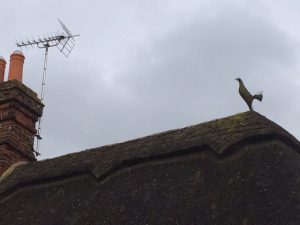
Football Themed Thatched Animal – Tottenham Hotspur Cockerel
Hamlet Stove Swept in Radwinter
I came across this rather attractive and elegant stove in a thatch property in Radwinter the other day. It is manufactured by a company called Hamlet Stoves and is not a make I had come across previously; hence its insertion in my weekly blog. Hamlet Stoves are a Devon based company that was set up in 1966, by a married couple Rode and George. The companies engineering works are actually based in Axminster, which of course is famous for its carpet manufacturing industry. The company is noted for their Hardy and DEFRA ranges of stoves, all of which have a blend of contemporary and traditional features.
The occupier told me that the stove provides excellent heat in what is a rather large lounge and which he said can get rather cold in the winter. He went on to say that the stove had been alight every day all through winter and was frequently the sole source of heating for the room. Consequently, upon cleaning, the stove flue was found to be rather dirty; however although a large quantity of soot was removed, it was of a very fine consistency showing that the stove had been operated correctly at its optimum performance.
In conversation with the occupier I discovered that the stove had been supplied and fitted by Will Parker of Thaxted Stoves. He told me that Thaxted Stoves had additionally built up the chimney so it was well away from the thatch and had further increased the height by adding a half meter tall chimney pot. I had to admit that it was a very neat and tidy job.
Thaxted Stoves:
Phone: 01371700305 or 07990511589
Email: info@ThaxtedStoves.com
http://www.thaxtedstoves.com
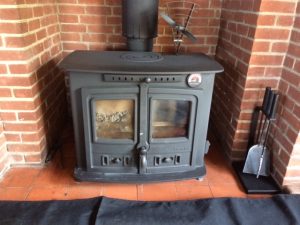
Thatched Aggression – More Fighting Hares
More hares, this time on a thatched roof in Stoke by Clare, indeed this is the second set of boxing hares that I have seen in Stoke by Clare; the first set were on a cottage in the middle of the villages whilst this pair are on a roof on the outskirts of the village when travelling from Wixoe. I know that you are thinking why do hares box in the first palace, well I’ll tell you all about it. Firstly it is not the male hares who box each other to win the right to mate with females as many people think, instead it will be a male and female who box each other. This happens when a male hare has been over zealous in his pursuit of a female in order to mate with her. What usually occurs is that the over persistent, unwanted attentions of the male become too much for the pursued female. For example the male might have chased the female across fields for some time in an attempt to mate. Eventually when the female has had enough of this, she’ll turn around and try to fend him off the persistent male suitor and a fierce boxing match will ensue! This mating behavior normally takes place in March giving rise to the expression, “mad as a March hare”.

Small Franco-Belge Stove Repaired and Swept
Recently I swept and repaired a small Franco-Belge stove for a customer in Thaxted. It is a common problem with wood-burning stoves that the door glass can break or crack from use. The usual causes for this are that the door is closed to heavily, or closed against a log or other obstruction. Unfortunately, many customers believe that their door glass is toughened in some way and is smash resistant; whilst their glass is heat-resistant it is not the case that it is smash-resistant. In this case I was able to remove the old broken glass, clean up the door and replace the glass for just £80.
As usual I sourced the glass from VetroSpec in Great Chesterford, I have not found anywhere else that is so reasonably priced and helpful. They will actually cut the glass for you whilst you wait! The proprietors Antonio & Penny Portente are ever so helpful and friendly, I would recommend them to anyone! – VetroSpec – Precision Glass Engineering, Unit 1 Park Farm, Park Road, Great Chesterford, Essex CB10 1RN – T01799531363 – Sales@vetrospec.co.uk – www.vetrospec.co.uk
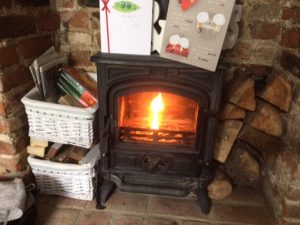
Thatched Animals on the Move – Running Hares
I saw these fantastic thatched hares running across the ridge of a cottage in Ashden (opposite the Rose & Crown pub) the other day. I think these are amazing thatched sculptures, perhaps the best I have seen; they are so animated and alive, giving a real sense of movement! Hares are rather fascinating animals, so here are some interesting facts about hares: Hares form part of the genus Lepus, the same family group as rabbits. Young hares are known as Leverets and the collective noun for a group of hares is a ‘drove’. Although, characteristically hares are a solitary animal or live in pairs; they live in a den formed on the ground which is called a ‘form’. A male hare was once called a Jack and a female a Jill. Mother hares have between 1 to 4 litters, usually three, a year, with one to four leverets per litter, with the Leverets being born from February to October. A new litter is conceived before the previous one has been born. Hares can run very fast reaching speeds of 45mph which is how fast these two on the roof are probably going! They also tend to run in straight lines, and if they are seen to turn whilst running it will normally be a right angle turn.
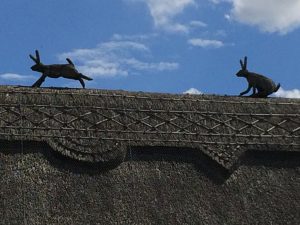
Large Coalbrookdale Severn Stove Swept
I recently swept this large Severn Stove in a house in Radwinter. They are a rather handsome, elegant if not a little old fashioned type of stove, but are well suited for large inglenook chimney places appertaining to large room spaces. Attractive features of the stoves are the decorative iron work, which includes latticework, decorative swans on the air intake controls and the name Severn on the top of the stove. The Coalbrookdale Company also manufactures another similar stove called the Darby which has similar ornate decorative features.
I am not sure whether these stoves are still in production and haven’t been able to find out one way or another from internet searches. I say this because I have seen a lot of Severn Stoves in and around the Walden area; in particular in Radwinter, Wimbish, Ashdon, Wendons Ambo and Arkesden to name a few. However, in all these instances the stoves have been in place for a long time, 30 years plus in some instances. This leads me to believe that the stove was very popular in the past, but is either no longer as popular, or is out of production. Certainly, at some time in the past there must have been someone in the Walden area who was installing Severn stoves as the stove of choice.
What I did find of interest whilst conducting my internet searches, was that the Coalbrookdale Company has an extremely long and interesting history that goes right back to the birth of the Industrial Revolution and far beyond. In the 12th Century the area of Coalbrookdale which is in Shropshire fell within the manor of Madeley, which belonged to Much Wenlock Priory. The monks here operated a bloomery (iron foundary) called “Caldebroke Smithy”. In 1536 bloomery recorded as still being in operation, however in 1540 during the dissolution of the Monistaries Much Wenlock Priory was closed by King Henry VIII, but the bloomery continued working. Then in 1544 the “Smethe Place” and “Calbroke Smethe” were leased to a Hugh Morrall. This is believed to refer to the Lower Forge (SJ667038) and Upper Forge (SJ669042). Before in 1545 the abbey’s lands being eventually bought by the king’s Italian physician, Agostino Agostini but he sold them in the same year (presumably at a profit) to a local man called Thomas Lawley. Then in 1572 the manor was acquired by John Brooke, who constructed a number of coal mines on his land and continued the operation of the bloomery.
In 1615 Brooke’s son, Sir Basil Brooke, bought the patent for making steel by the cementation process and built a blast furnace at Coalbrookdale. Interestingly, Brooke was arrested in 1644 by Parliament after being involved in a plot to prevent the Scottish army taking part in the English Civil War. The following year Brooke’s estate was sequestrated by Parliament but the works continued in use. Then in 1651 the manor was leased to Francis Wolfe, the clerk of the ironworks, by Brooke’s heirs. Brooke had died in 1646 so presumably Parliament had returned the manor to his family. In 1658 – a new blast furnace and forges were built. In 1688 the ironworks were leased by a Shadrach Fox, who in 1696 was supplying round cannon shot and grenado shells to the Board of Ordnance during the Nine Years War. Unfortunately in 1703 the furnace blew up but the forges remained in use.
In 1709 Abraham Darby I acquired the lease and created the Coalbrookdale Company, an iron foundry which used coke as fuel to make pots and pans. The company had a very long history and is famous for making the first iron bridge which still stands to this day. In 1945 the company started manufacturing wood-burning stoves and the Rayburn cooker. In 1969 the company was absorbed into Allied Ironfounders Ltd.
As an interesting aside, my dad was evacuated to Coalbrookdale at the beginning of the Second World War; he subsequently spent the war living with an elderly widow helping to run her small holding.
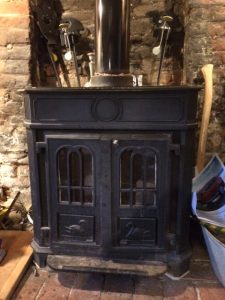
Another Thatched Animal Family – Mother Fox & Her cubs
Here is another family of thatched animals that I spotted in Stoke by Clare when I was out working the other day. I thought that this family grouping looks rather cute, but I should think that there are many country people who view foxes as vermin, who would not be of the same opinion. Did you know that fox cubs are born in the spring with the mother usually giving birth to between 4 to 5 cubs; the mother gives birth in a den which she rarely leaves when the cubs are young. The mother’s pregnancy lasts for fifty three days which is just a little shorter than a domestic dog. The choice of dens is very varied, and they can be above or below ground, for example, reused earths of other animals like badger sets, and unused or unoccupied buildings and garden sheds. To begin with the cubs are blind and deaf and their fur is very short and black in colour. Initially the father fox will bring food to the den to help feed the mother fox whilst she is suckling the cubs. During this time mother and cubs do not leave the den as the cubs are totally dependent upon the mother for food and warmth. After a time the mother begins to start leaving the den, progressively spending more and more time away from the cubs. After about a month the cubs begin to leave the den, exploring the local environment for short periods. It is at this time that the cubs begin to start eating solid food and are well on the way to adulthood. If you keep your eyes peeled you might be able to spot some fox cubs in the late spring.

Olsberg Stove Condemned
I recently had to condemn a stove in a customer’s property near Arkesden. Put simply this process formally advises the customer not to use an appliance because it is dangerous and indicates that remedial work should be undertaken to correct the issues before it is used again. Clearly, I or anyone else for that matter cannot prevent a customer from using a dangerous appliance if they so wish, however once an appliance has be condemned by a Guild of Master Sweeps Member and the requisite documentation raised, a customer would be foolhardy in the extreme to continue using the appliance. For example, if through such use any person was injured or property damaged, such injury, loss, or damaged would invariably not be covered by the customer’s household insurance policy.
Having said all this, condemning an appliance is not a step lightly taken by any sweep as it deprives the customer of the use of their appliance during the period of time it takes to have the fault rectified. In this instance, the customers had not long moved into the property, they had noticed the problems with the stove and they had the safety of their young children to consider – So the stove being condemned was not an issue for them. In addition, I was also able to pass on the details of Will Parker of Thaxted Stoves to the customer to help in having the necessary repairs effected as soon as possible, as such remedial work is another aspect of the type of work carried out by this company over and above fitting new stoves.
The stove itself a large Olsberg was not the issue in this instance and was actually a very good stove and adequately sized for heating what was a rather large room. The problem was that the register plate which was only made of flame board had failed at the front and was leaking insulation material into the room. Consequently, with such a fault there was a very real danger if the stove were to be used carbon monoxide could leak into the room.
Olsberg are a German stove company who specialized in modern, contemporary stoves, some of which use alternative fuel sources such as pellets.

A Family of Thatched Animals – Mother Duck & Her Chicks – Cornish Hall End
I saw this family of ducks on a Thatched Property in Cornish Hall End where I swept the chimney and completed a CCTV examination for insurance purposes. Again this blows a hole in my theory that that thatched animals are mostly associated with hunting and shooting; whilst a duck is certainly a game bird that might be hunted and shot, I don’t think anyone would be shooting little chicks! So it is looking that the choice in thatched animals is driven by the owners personal taste, so where owners might be interested in field pursuits this can be reflected in their choice of thatched animals. What is not in dispute is how sweet this little family group look, quite the most pleasing group of thatched animals that I have seen so far!
As I say, I’m always on the lookout for thatched animals around the local area, but if any of my customers spot any out there, I would be more than glad to hear from you on Face Book!
Two Franco-Belge Stoves Repaired and Swept
In the past I have repaired and swept two Franco-Belge Stoves for two different customers; one of the stoves was a Merville, whilst the other was a Montfort. The issue with these stoves is that the grate expands with heating and then cannot be removed from the stove with ease. This is a problem because the grate has to be removed before the baffle/throat plate is removed to gain access to the flue for sweeping. I can only think that this issue with the grate is a design fault with these models of stove as it occurs wherever you find these types of Franco-Belge Stoves. The stove is also quite complex to dismantle and must be done in a particular order and in a particular way, otherwise it will not come to pieces. Firstly the two fire-retaining bars have to be removed; these sit on top of each other at the front of the fire-box. Next the rear fire-brick has to be removed; this is extracted from the bottom first and pulled forward; there are two diagonal indentations at the bottom of the brick that assist in gripping it for removal. It is then rotated so that it can be completely removed from the stove. The two side bricks are then removed in turn, again lifting them from the bottom. It is at this point that the grate can now be removed by lifting it upward from the rear until it clears the baffle, which somewhat unhelpfully slopes forward restricting the grates removal. Once lifted clear at the rear from the baffle the grate can be pulled forward, rotated and removed from the stove. Finally, the baffle can be removed by dropping it off the rear ledge on which it sits, it is then pulled forward, bottom first, just like the rear fire-brick, before it is rotated and removed from the stove. Frequently, the two baffle gaskets will fall lose into the firebox when the baffle is removed. These gaskets sit on top of either side of the top of the baffle. These can simply be stuck back in place on top of the baffle using heat resistant silicone and allowed to dry whilst the chimney is swept.
I hear you ask though, ‘how can you sweep the chimney of one of these stoves if the grate has expanded and is wedged in place’? One rather expensive option would be to have an inspection hatch cut in the stove pipe which would allow access to the flue. As I say, this would be expensive and it does not facilitate cleaning the top and rear of the baffle where soot and tar can collect and impede the efficient operation of the stove. A cheaper alternative way of repairing the stove is to pries out the grate using a large crowbar. A small amount of the rear of the grate can then be removed by grinding, so that it once again fits the stove correctly. This is the method I used last week to repair both stoves. Having removed the grates I took them to Springwell Forge in Ugley, where the Blacksmith David Gowlett removed the requisite amount from the rear of both grates. David is a handy man to know, on previous occasions he has repaired or totally re-fabricated stove baffles for me at a very reasonable cost. David has been a blacksmith since 1978 and has been running the forge at Ugley since 1989; he is a true craftsman. David Gowlett – Springwell Forge, Cambridge Road, Ugley CM22 6HY 01799546270 – springwellforge.co.uk
Franco Belge are one of Europe’s leading stove manufacturers and have been producing high quality stoves for over 80 years.
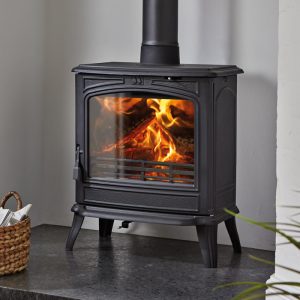


 My name is Paddy McKeown, I am a retired police officer (Detective Sergeant – Metropolitan Police), turned chimney sweep. I have completed training with ‘The Guild of Master Chimney Sweeps’, and Rod Tech UK (Power Sweeping).
My name is Paddy McKeown, I am a retired police officer (Detective Sergeant – Metropolitan Police), turned chimney sweep. I have completed training with ‘The Guild of Master Chimney Sweeps’, and Rod Tech UK (Power Sweeping).



